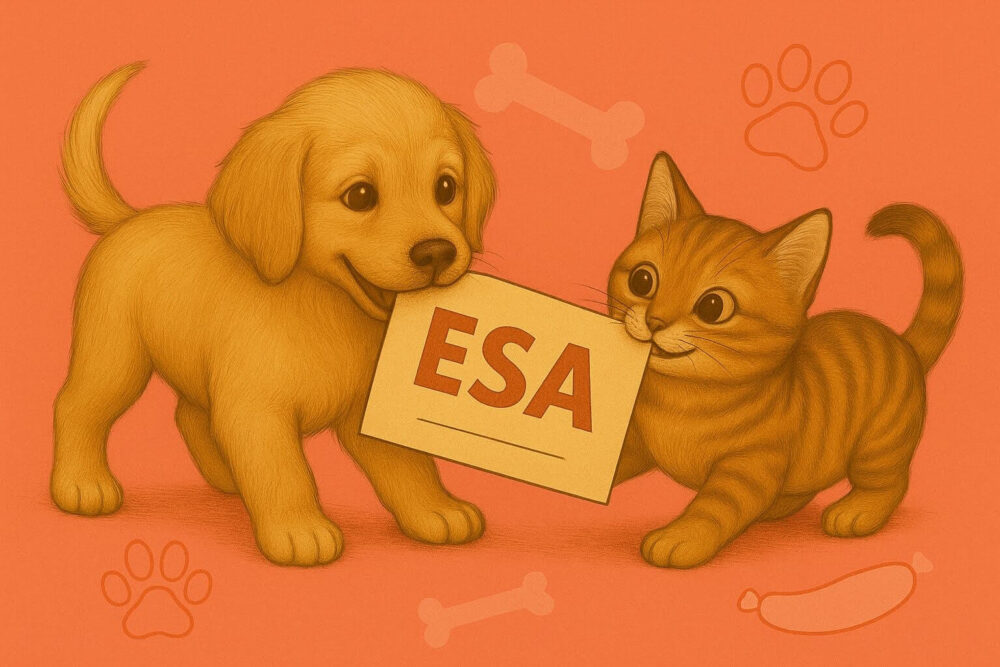
Table of Contents
Emotional support animals (ESAs) are far more than adorable pets for many people struggling with mental health. They offer steady comfort, unconditional companionship, and a sense of calm that can make even the hardest days manageable.
But what if one furry (or feathered, or scaled) friend isn’t quite enough? Maybe your cat helps quiet your anxiety while your dog encourages you to stay active. Or maybe having multiple ESAs helps combat feelings of isolation and provides an even deeper sense of support.
Still, can you have more than one emotional support animal? We’ll explore what the law says about keeping your whole support crew under one roof and what to consider before bringing multiple cuddly friends into your home.
When Might You Need More Than One Emotional Support Animal?
Having more than one ESA isn’t just about doubling up on cuddles (though that’s a pretty great perk). You might turn to multiple ESAs for many practical and personal reasons, depending on whether you need them for:
| Scenario | Explanation |
| Supporting different symptoms of the same condition | Even if you’re managing just one mental health challenge, it’s normal to experience a range of symptoms that require unique support. For example, if you’re battling depression, a dog might help energize you through daily walks, while a cat may provide comfort when you’re feeling low and need some quiet company |
| Managing different conditions | If you’re balancing multiple mental health challenges, each of your furry friends can help you cope with one. For example, one ESA might help you feel grounded during PTSD episodes, while another soothes your anxiety symptoms with cuddles and comfort |

How Many ESA Pets Can You Have?
Technically, you can have as many emotional support animals as you want! There’s no set limit, as long as each animal supports a different aspect of your mental health and is recommended by a licensed mental health professional (LMHP).
This is thanks to the Fair Housing Act (FHA), the main federal law covering ESAs. At their core, these regulations protect ESA owners from housing discrimination, and they don’t put a cap on the number of ESAs you can bunk with.
The FHA also makes sure that:
- Landlords must allow ESAs, even in “no pets” housing
- They can’t charge you pet rent or deposits
- Size, breed, and species restrictions don’t apply to your ESA companion
These protections take the stress out of applying for housing with your ESAs in tow, especially if your support squad is bigger than usual.
Still, to access all these perks, you’ll need valid documentation for all your animal friends. The only such piece of paperwork that the FHA recognizes as proof of the animals’ ESA status is an ESA letter.
Housing Considerations for Multiple ESAs
While having the right documentation is a key piece of the ESA housing puzzle, you still need to prove your request fits within reasonable expectations. In some cases, your ESAs can be denied even with a valid letter. Here are a couple of things that can tip the scales when you’re asking to keep multiple buddies at home:
- Type of animals
- Compatibility
- Impact on others
Type of Animals
Though the FHA prevents landlords from imposing breed or size restrictions on your animal buddies, they still have to be domesticated animals that don’t pose a direct threat or cause major property damage.
When getting ESAs, most people stick with familiar companions like dogs, cats, rabbits, or birds. But some take the path less traveled, finding comfort in animals that might raise a few eyebrows, like:
- Ferrets
- Miniature pigs
- Snakes
- Chickens
If your ESAs are less typical types of animals, you might run into some resistance from your landlord, especially if the space isn’t big enough to hold multiple animals of larger breeds. If this happens, your LMHP might need to be more specific when explaining how they benefit you.
Still, all is not lost. The FHA protects unconventional animal choices, having helped people successfully fight for their ESA chickens and even emus. That said, there’s a limit: the FHA doesn’t cover exotic or wild animals, and your landlord can legally reject your ESAs if they fall under this category.
Compatibility
Your ESAs don’t just have to live with you; they’re also each other’s roommates. Any tension or aggression between them can turn them into the opposite of model tenants, undermining their emotional support role.
This is something your LMHP might consider when prescribing you multiple ESAs in the first place. To make sure your support squad can live together peacefully, they might ask about:
- Each animal’s usual behavior
- Their experiences living with other pets
- The overall temperament of all your furry friends
Even so, your landlord can’t predict how your ESAs will interact based on your initial request. They mostly rely on the information you provide, but they’re allowed to deny your request if it’s clear that your buddies’ disagreements could result in major property damage. If problems arise after you move in, your landlord can also reevaluate the situation based on how the animals currently behave.
Impact on Others
While having multiple ESAs means more emotional support for you, it can also mean more disruption for those around you.
Even if your ESAs are generally well-behaved, their impact multiplies quickly when they’re together in one place. For example, your apartment building could be sound asleep in the middle of the night when your two ESA dogs suddenly burst into a loud game of chase, waking up the whole neighborhood with all the barking and clawing.
This could be equally as little fun for you as for your neighbors. Noise complaints, strained neighbor relationships, and even lease violations could follow.
As the owner, it’s your responsibility to make sure your ESAs coexist peacefully with the entire community. This may require extra training, more careful supervision, and even strategic separation of your little buddies during high-energy times.

How Many Animals Does an ESA Letter Cover?
With all the housing considerations out of the way, you might run into a final conundrum before moving in with all your support companions—do you need a separate letter for each, or can they all share one?
An ESA letter typically covers one emotional support animal because this is enough for most people to have their mental health needs met. However, a single ESA letter can apply to multiple animals for those with more than one ESA in their support team.
While there’s no strict legal limit on the number of animals one letter can cover, most ESA letter providers issue documentation for two to three animals at once. That’s because it’s very rare that someone needs more than this for complete emotional support, and such requests would usually require stronger clinical justification.
If you’re requesting a letter for more than one animal, what’s important is that the provider properly evaluates your need for each one, not automatically include them all without a proper assessment. Without this key step, your letter might be invalid and lead to a range of unpleasant consequences, including possible eviction and damage to your rental record.
How To Get an ESA Letter for Multiple Emotional Support Animals
The traditional process of getting an ESA letter for multiple animals is no different than qualifying for a single ESA. More animals might mean more time and effort, but the steps you’ll need to take are basically the same:
- Find an LMHP in your area: You’ll need to zero in on a professional near you who has the right credentials and issues ESA letters. This could be a therapist, psychologist, psychiatrist, clinical social worker, or nurse practitioner who’s licensed in your state to diagnose emotional and psychological conditions
- Schedule an appointment and get evaluated: When you meet with your LMHP, they’ll assess your symptoms and compare them against the qualifying conditions outlined by the DSM-5-TR, like depression or anxiety. They’ll also consider your need for multiple ESAs and their distinct roles in helping you manage your condition
- Receive your ESA letter: If approved, the LMHP will write you an ESA letter within a few days to a couple of weeks. To be valid, the letter needs to include your LMHP’s National Provider Identification number, state license number, and contact details for verification. It should also be written on their official letterhead and describe each animal’s role in your emotional well-being
Between looking for professionals, scheduling appointments, and waiting for approval, getting an ESA letter the traditional way can be long and hard. This is especially true when you have more than one animal friend, which might require more trips to your LMHP.
The good news is you can skip the hassle with an online platform like Your Service Animal. Through the service’s fully digital platform, you can quickly get a valid ESA letter that covers up to three animals at once, with no hidden risks or delays.
Make Your Whole Support Crew Official With Your Service Animal
Your Service Animal takes the stress out of getting legitimate ESA letters by connecting you with qualified professionals from the comfort of your home. This fully online platform streamlines every step, saving you time and energy while ensuring your letter for all your support friends meets legal standards for housing accommodations.
Here’s what makes Your Service Animal stand out:
| Benefit | What It Means for You |
| Free pre-qualification quiz | Quickly find out if you’re likely to qualify before investing any time or money |
| 100% online process | No office visits, no long commutes. Just simple, secure evaluations from wherever you are |
| Licensed professionals in your state | Each ESA letter is issued by a vetted mental health provider who’s authorized to practice in your state and fully familiar with ESA rules |
| Fast 24–48 hour turnaround | Get the documentation you need without delay; perfect for urgent housing situations or busy schedules |
| 100% money-back guarantee | If you’re not approved or your landlord rejects your letter, you get a full refund, no questions asked |
How It Works
Ready to make life easier for yourself and your adorable roommates? Here’s how to get started:
- Find out if you’re a good fit for an ESA letter with our online quiz
- Schedule an online appointment with a licensed mental health practitioner in your state
- Attend the online call and receive your ESA letter if clinically appropriate
- Receive a full refund if the therapist doesn’t issue an ESA letter or your landlord rejects your letter








